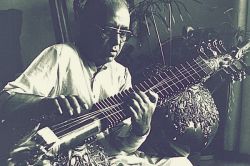Dagar veena
The Dagar Veena—also known as the Rudra Veena—is an ancient and revered string instrument with origins in the Indian subcontinent. It is deeply rooted in the history of Hindustani classical music. The name "Rudra Veena" translates to "the veena dear to Shiva," as it is believed that Lord Shiva himself created the instrument inspired by his wife Parvati. Another story attributes the invention of the Rudra Veena to Ravana who named it in devotion to Lord Shiva.
The Rudra Veena has a distinctive construction featuring a long tubular body made of wood or bamboo and typically measuring between 54 and 62 inches. It has resonators made from hollowed gourds and is adorned with 24 wooden frets and seven strings—four main strings and three chikari (drone) strings. The instrument produces a rich and resonant sound.
While the Rudra Veena was once widely played, its popularity declined with the introduction of the surbahar in the 19th century. However, in the 20th century, musicians like Zia Mohiuddin Dagar and Lalmani Misra made modifications to the instrument ensuring its continued presence in classical music. Today, the Dagar Veena is an instrument of great cultural significance cherished for its deep musicality and historical legacy.

